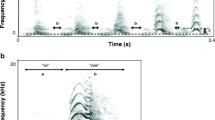Abstract
The “loud” calls of forest primates consist of repeated sounds that elicit a response from other members of the species. Recent studies suggest that these calls are often displays by the males that permit them to assess the strength of their opponents. Previous research on red howler monkeys supported the hypothesis that howling functions in assessment of competing individuals, as an alternative to energetically expensive chases and fights. As the second step in the attempt to understand the evolution of howling in genus Alouatta,one aspect—call duration — was compared in two species,the mantled howler (Alouatta palliata)and the red howler (A. seniculus).In A. palliatathe median howl duration was 3.5 sec and the interhowl interval was 20.0 sec, while in A. seniculusthe median howl duration was 19.0 sec and the interhowl interval was 3.0 sec. During the dawn chorus, the total duration of calling in A. seniculusmay be 10 or more times greater than that in A. palliata.The latter species appears to be limited in the duration of howls it can produce, so it increases the amount of calling by reducing the interhowl interval. At least four factors may be important in the evolution of the observed differences in call structure: constraints of the acoustic environment, alternate forms of display used by A. palliata,the presence or absence of competing males within the troop, and the effect of female calls on male howling. The observations suggest that the use of the male loud call may reflect differences in the nature of male-male competition and female support more than it reflects the constraints of the acoustic environment.
Similar content being viewed by others
References
Bachmann, C., and Kummer, H. (1980). Male assessment of female choice in Hamadryas baboons.Behav. Ecol. Sociobiol. 6: 315–321.
Baldwin, J. D., and Baldwin, J. I. (1976). Vocalizations of howler monkeys (A. palliata) in southwestern Panama.Folia primatol. 26: 81–108.
Byrne, R. W. (1982). Primate vocalizations. Structural and functional approaches to understanding.Behaviour 80: 241–258.
Olivers, D. J. (1969). On the daily behaviour and spacing of howling monkey groups.Folia primatol. 10: 48–102.
Clutton-Brock, T. H., and Albon, S. D. (1979). The roaring in red deer and the evolution of honest advertisement.Behaviour 69: 145–169.
Crockett, C. M., and Sekulic, R. (1982). Infanticide in red howler monkeys (Alouatta seniculus). In Hausfater, G., and Hrdy, S. B. (eds.),Infanticide in Animals and Man, Cornell University Press, Ithaca, New York.
Froehlich, J. W., Thorington, R. W., Jr., and Otis, J. S. (1981). The demography of howler monkeys’ (Alouatta palliata) on Barro Colorado Island, Panama.Int. J. Primatol. 2: 207–236.
Gaulin, S. J. C., Knight, D. H., and Gaulin, C. K. (1980). Local variance inAlouatta group size and food availability on Barro Colorado Island.Biotropica 12: 137–143.
Haimoff, E. H. (1983).The Organisation and Sound Production of the Song of the Gibbons: With Phylogenetic and Taxonomic Implications, Ph.D. thesis, University of Cambridge, Cambridge.
Hershkovitz, P. (1949). Mammals of northern Colombia. Preliminary report No. 4: Monkeys (Primates), with taxonomic revisions of some forms.Proc. U.S. Nat. Hist. Mus. 98: 323–427.
Hrdy, S. B., (1977).The Langurs of Abu, Harvard University Press, Cambridge, Mass.
Leighton, M., and Leighton, D. R. (1982). The relationship of size of feeding aggregate to size of food patch: Howler monkeys (Alouatta palliata) feeding inTrichilia cipo fruit trees on Barro Colorado Island.Biotropica 14: 81–90.
Milton, K. (1980).The Foraging Strategy of Howler Monkeys, Columbia University Press, New York.
Oates, J. F., and Trocco, T. F. (1983). Taxonomy and phylogeny of black-and-white colobus monkeys: Inferences from an analysis of loud-call variation.Folia primatol. 40: 83–113.
Packer, C., and Pusey, A. (1979). Female aggression and male membership in troops of Japanese macaques and olive baboons.Folia primatol. 31: 212–218.
Sekulic, R. (1982a). The function of howling in red howler monkeys (Alouatta seniculus).Behaviour 81: 38–54.
Sekulic, R. (1982b). Behaviour and ranging patterns of a solitary female red howler (Alouatta seniculus).Folia primatol. 38: 217–232.
Sekulic, R. (1983a). Male relationships and infant deaths in red howler monkeys (Alouatta seniculus).Z. Tierpsychol. 61: 185–202.
Sekulic, R. (1983b). The effect of female call on male howling in red howler monkeys (Alouatta seniculus).Int. J. Primatol. 4: 291–305.
Strum, S. C. (1982). Agonistic dominance in male baboons: An alternate view.Int. J. Primatol. 3: 175–202.
Waser, P. M. (1983). The evolution of male loud calls among mangabeys and baboons. In Snowdon, C. T., Brown, C. H., and Petersen, M. R. (eds.),Primate Communication, Cambridge University Press, New York, pp. 117–143.
Author information
Authors and Affiliations
Rights and permissions
About this article
Cite this article
Sekulic, R., Chivers, D.J. The significance of call duration in howler monkeys. Int J Primatol 7, 183–190 (1986). https://doi.org/10.1007/BF02692317
Received:
Revised:
Issue Date:
DOI: https://doi.org/10.1007/BF02692317



